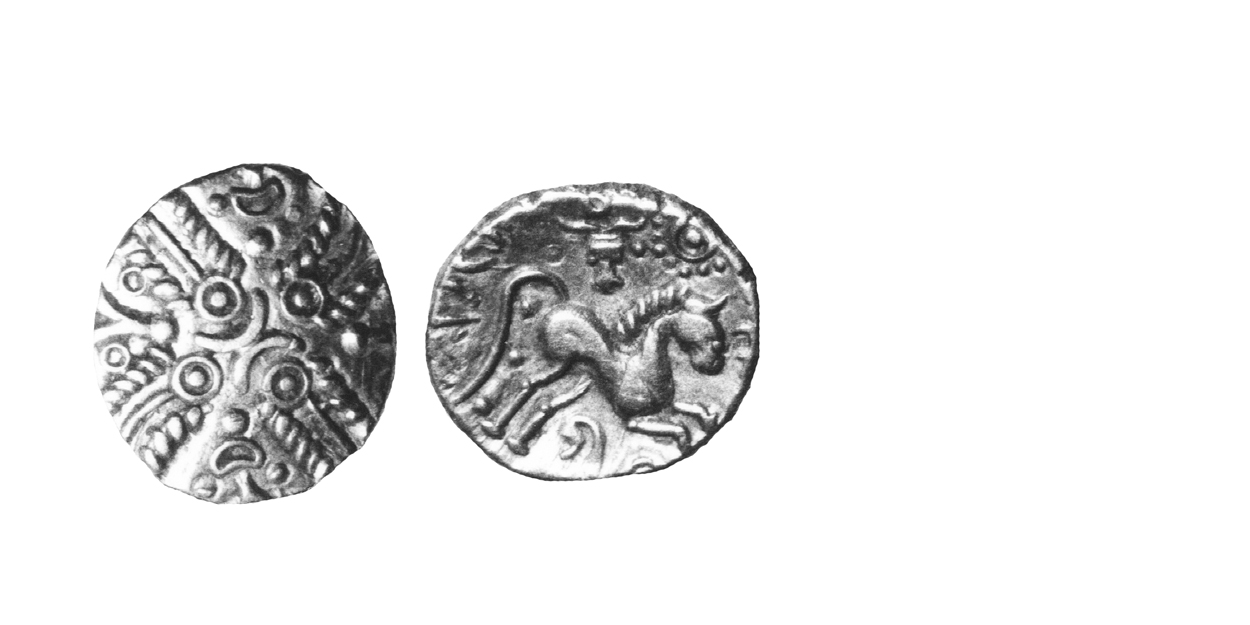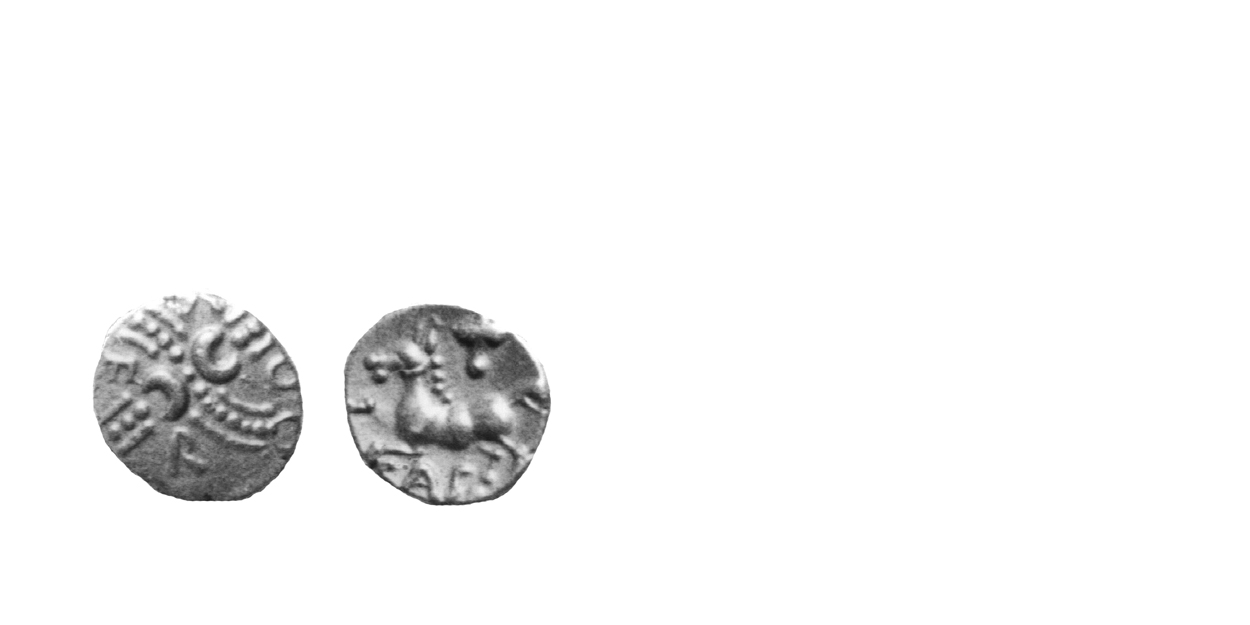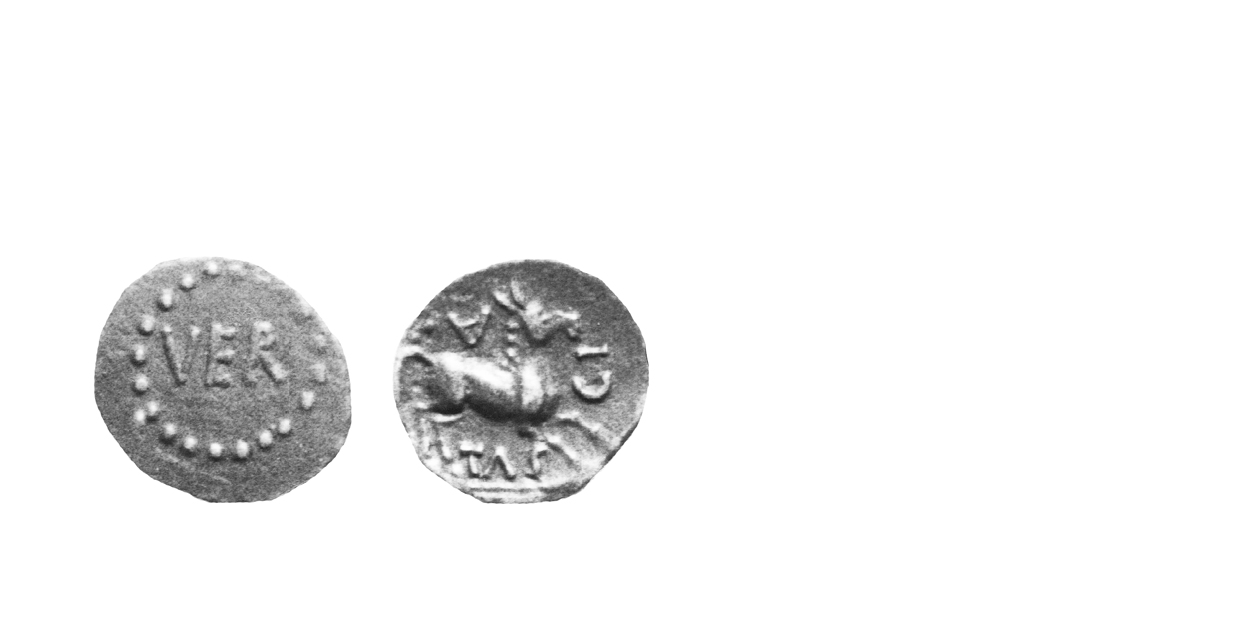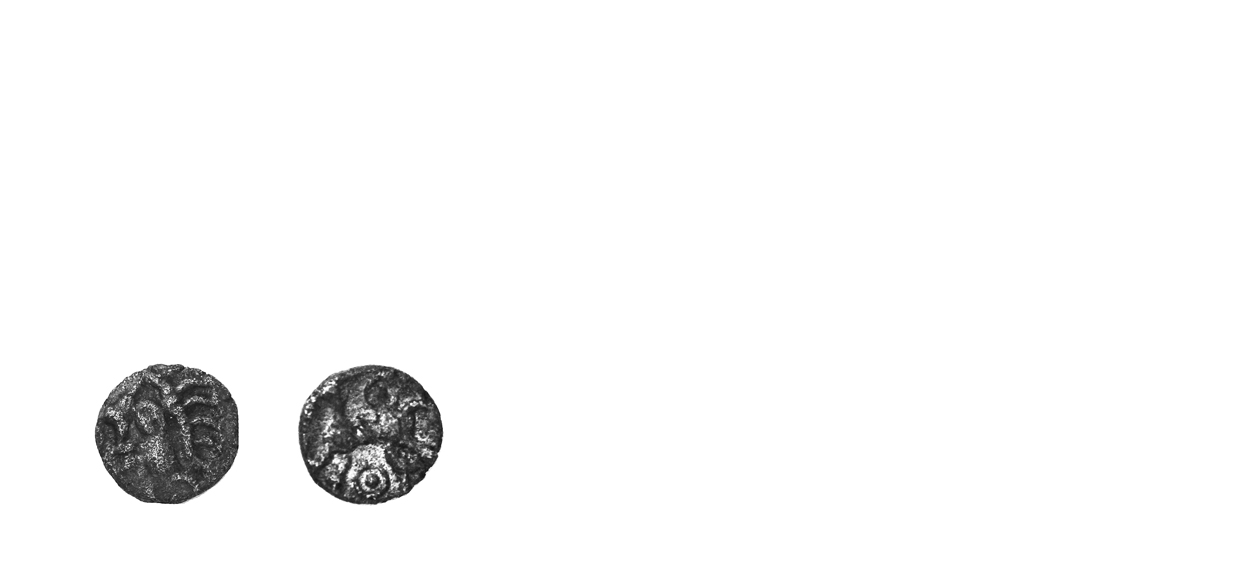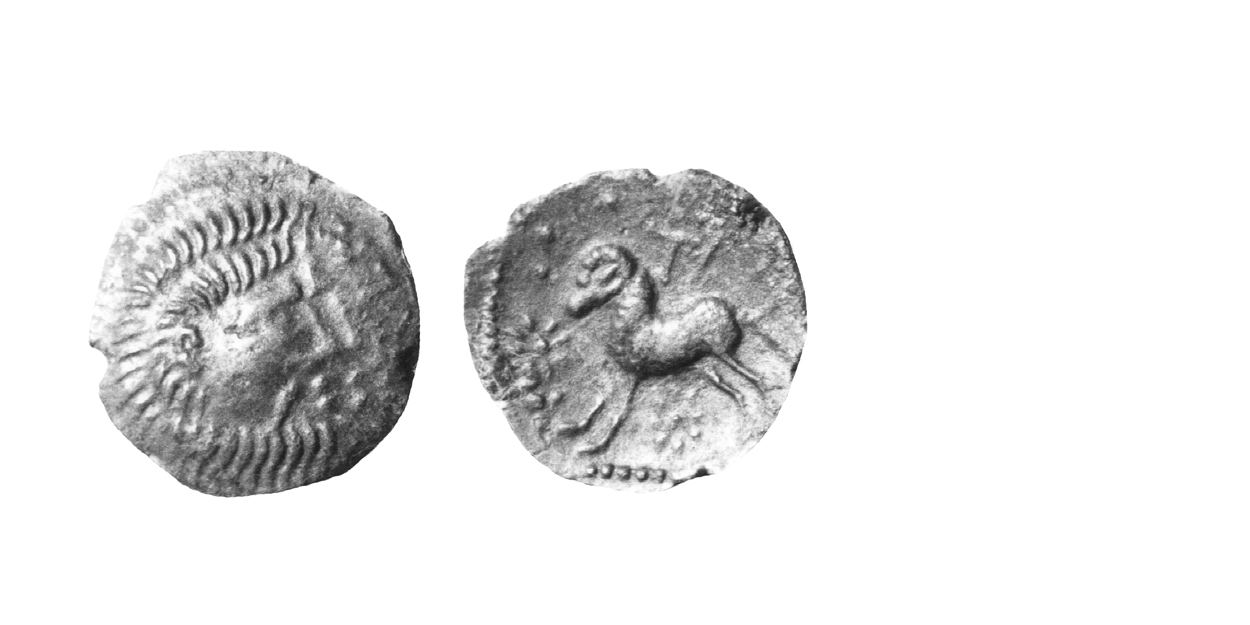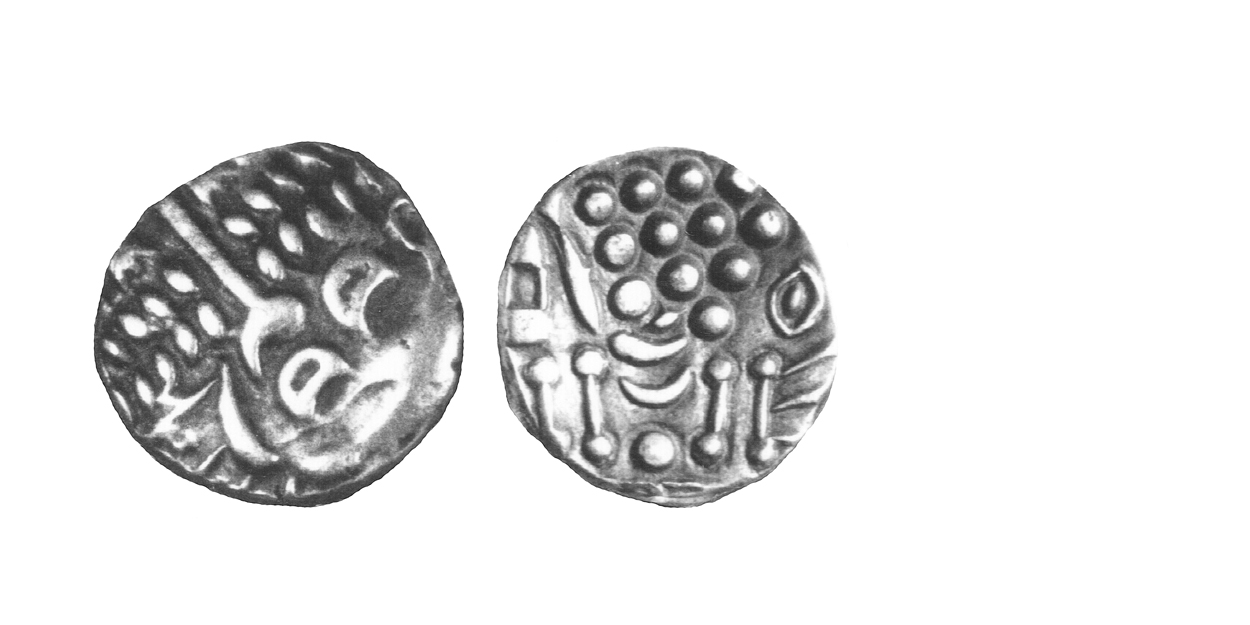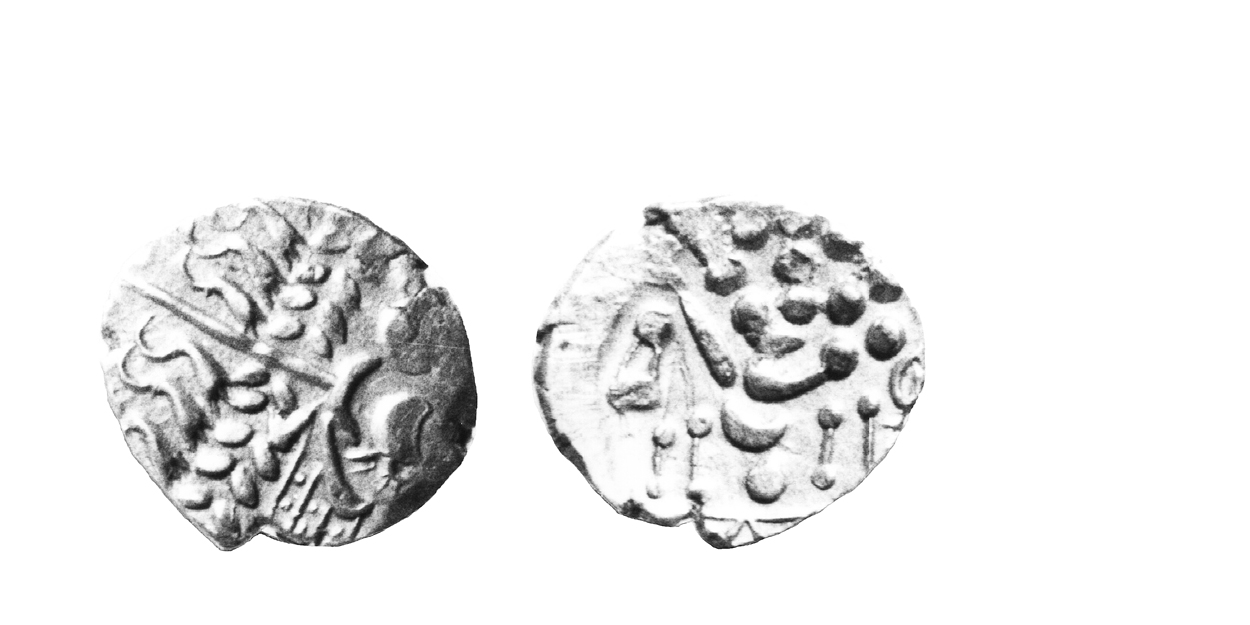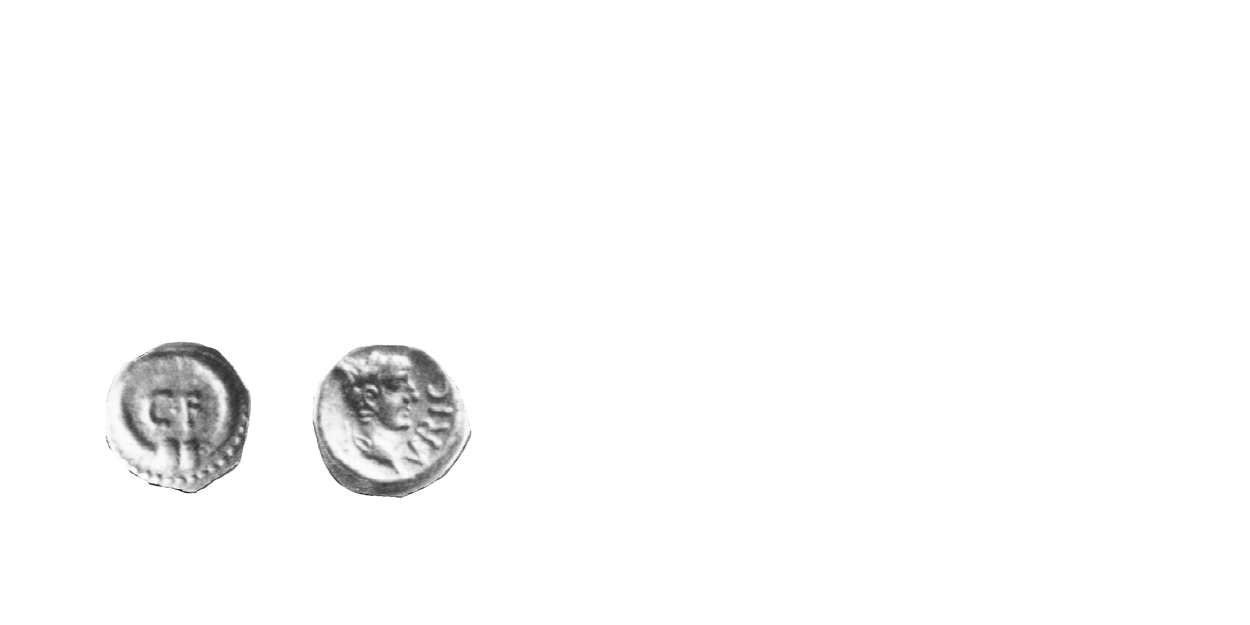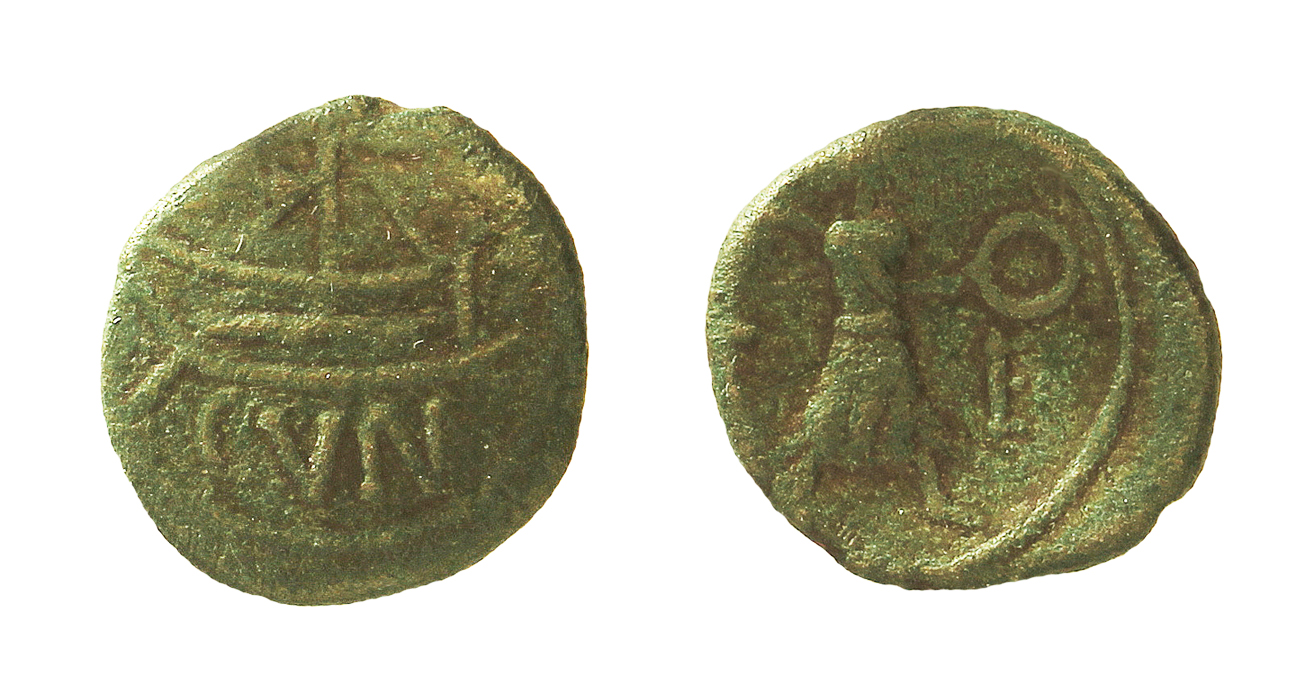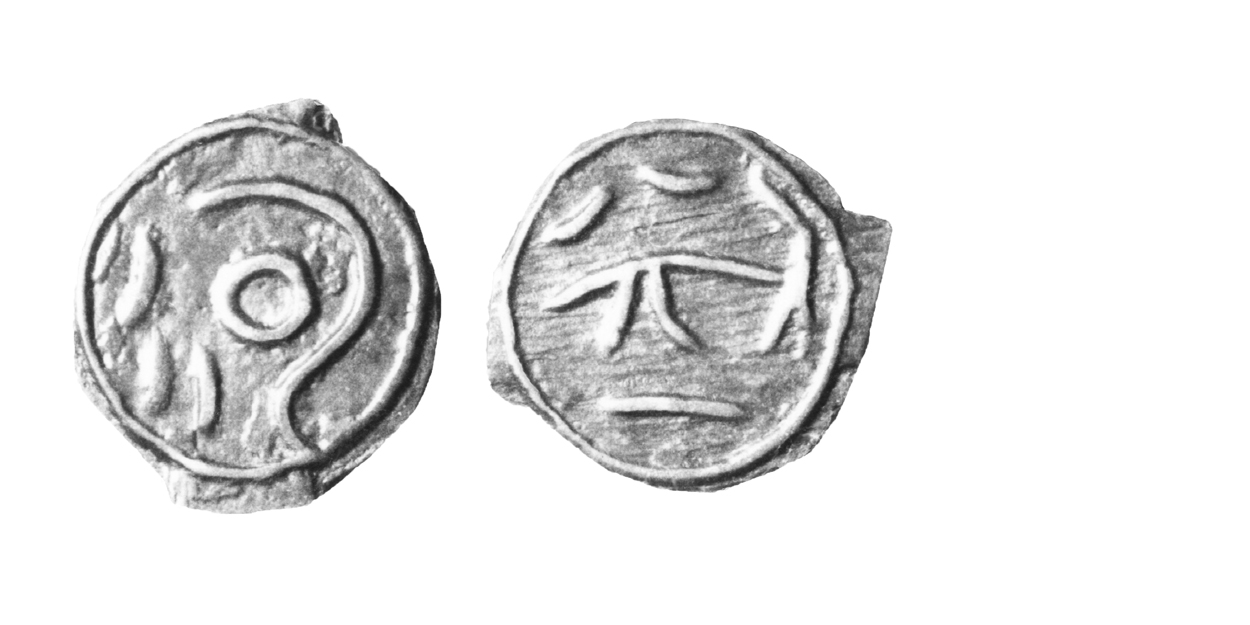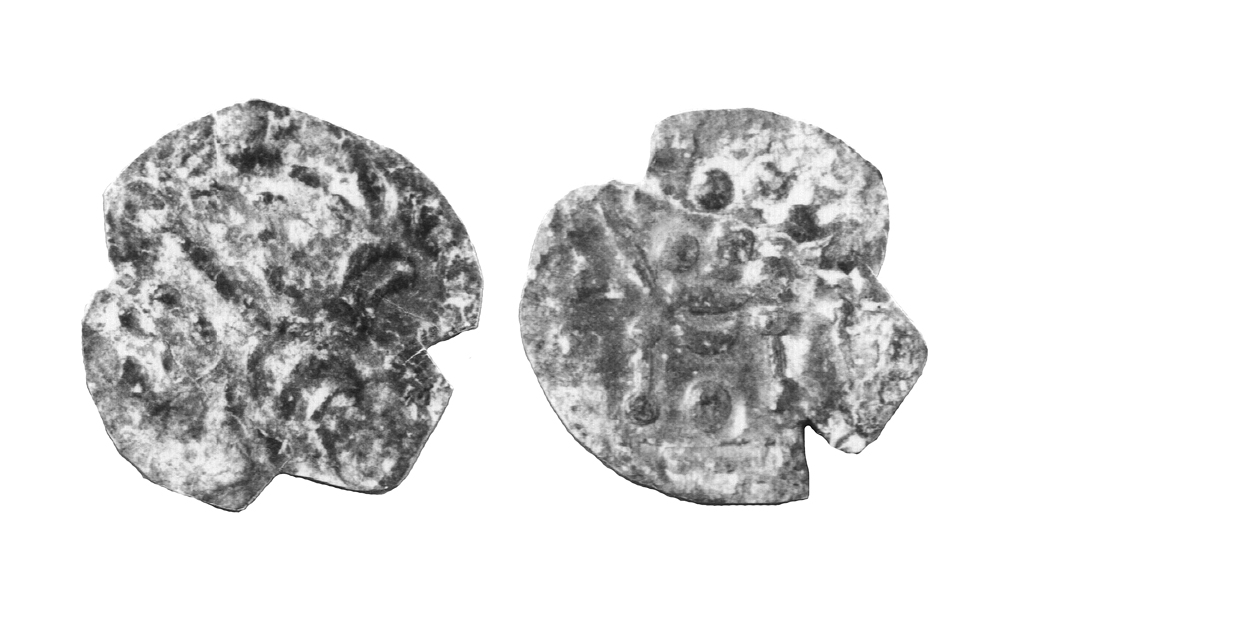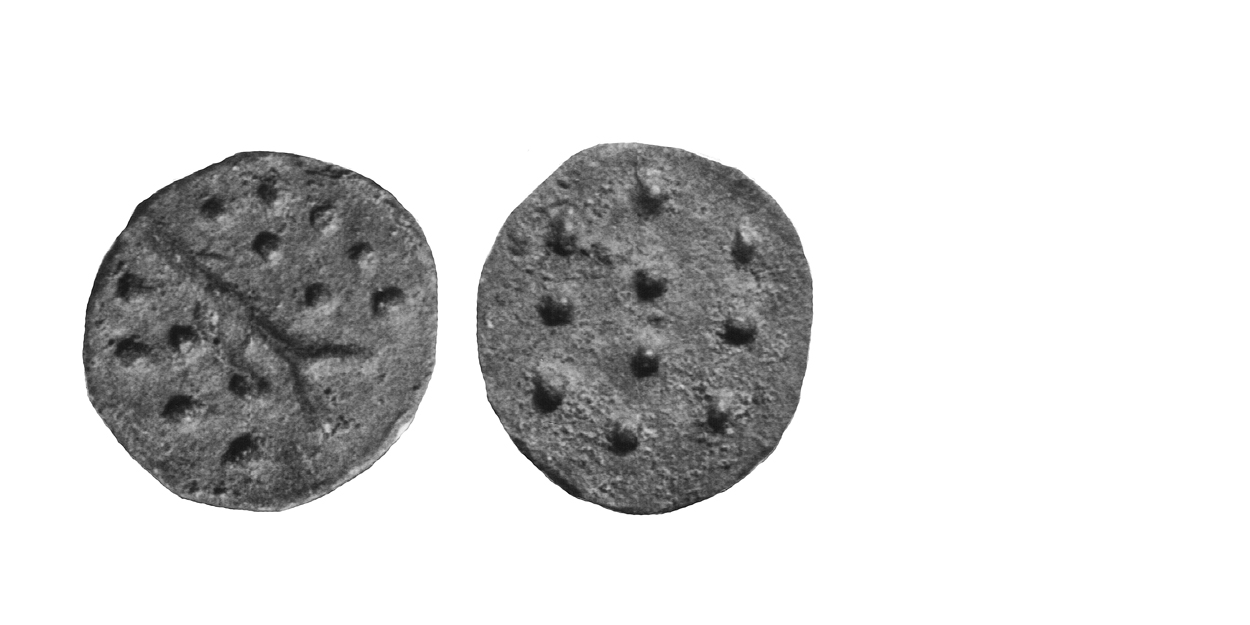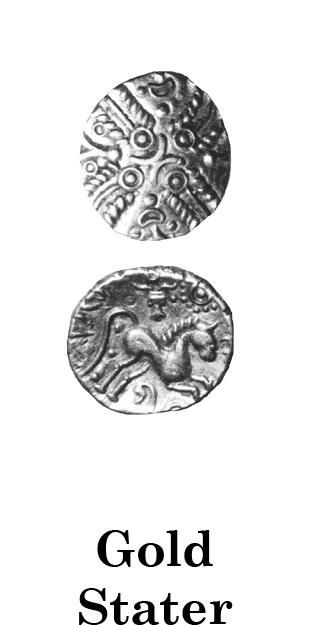
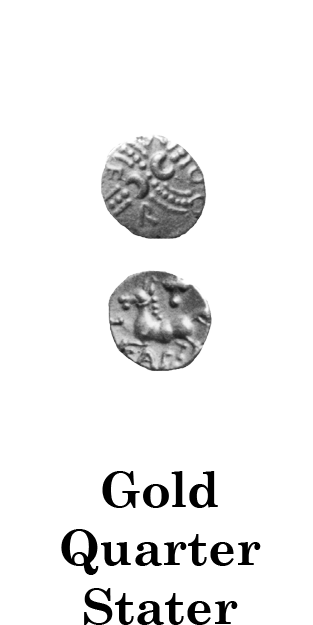
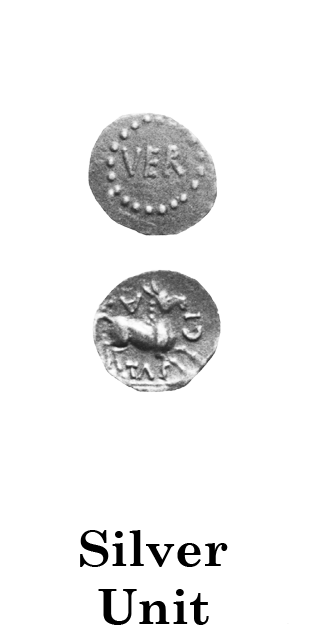
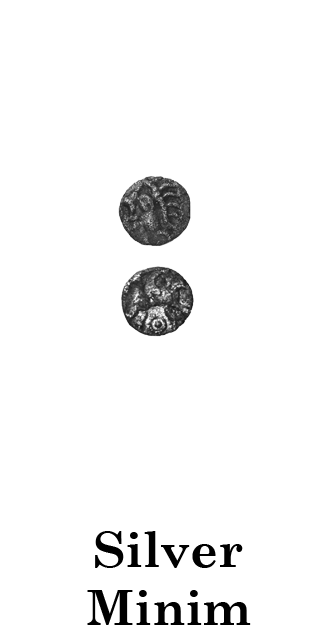
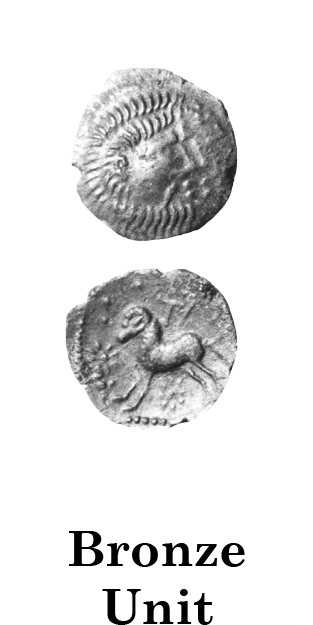
About the Coins
Denominations (Info)
With the exception of the Durotriges, the Celtic tribes used five basic denominations throughout the late Iron Age: the gold stater and quarter stater, the silver unit and half unit (or alternatively a minim), and the bronze unit.
Gold Staters
Gold staters, initially imported from northern Gaul about 125 B.C., were the premier coins. The first import, the Large Flan Type, had a 27 mm diameter and weighed 7.8 gms – an impressive coin. The weight of the Celtic stater gradually dropped, however, and by 75 B.C. it stood at 6.45 gms. The British tribes produced their own versions shortly after and these conformed to the prevailing weight standard. As the standard continued to drop, the British tribes successively reduced the weight of their coins – the last weighed only 5.40 gms.
As the weight fell, the moneyers also reduced the gold content, at first replacing gold with silver. After the Gallic War, they replaced both gold and silver with copper. The staters are at first yellow-coloured, but when the copper content increased, they became reddish. The change was very gradual, however, and it is unlikely the average person would have detected the debasement over a ten-year period.
Measuring the gold content is not a simple matter. Specific gravity is a questionable indicator because the staters are made of three-way alloys. Normally, X-ray fluorescence or electron microprobe studies must be performed to determine the metallic content of a given coin.
All Celtic staters are struck on dish-shaped flans, with the obverse on the convex side and the reverse on the concave. For this reason, the reverses are often better preserved – the concavity protects the reverse from wear. It is not unusual for staters to carry a different preservation grade for the two sides. Staters also suffer flan splits at the edges as a result of striking between curved dies. Splits are not a grading concern in this series, but coins with minimal splitting are difficult to find. Sometimes, a flattened coin is encountered and these lack the concave form. In such cases, the flan splits are usually more severe.
Gold Quarter Staters
Gold quarter staters, as a class, are generally quite rare, although there are exceptions. Often they were issued as smaller versions of the staters at a quarter the weight, but sometimes the relationship between the fractional denomination and the stater is not so clear. Diameters run from 14 to 8 mm, and typical weights from 2.0 to 0.7 gms. Though struck on dish-shaped flans, striking splits are not as pronounced as on the staters because of the smaller diameters. Some very late quarter staters have such small diameters, they do not appear dish-shaped at all. At all times, a high level of die-cutting craftsmanship was maintained and consequently these little coins are often impressive masterpieces of pre-Roman Celtic artistry.
Silver Staters
The largest silver coin used in Britain was the Durotrigan silver stater. The Durotriges had traditional ties to the Armorican peninsula, an area of Gaul populated by silver-using tribes. Trading contact with this area resulted in the adoption of silver coins and the Durotrigan coinage consequently remained outside the mainstream of British types for much of its history. The Durotrigan silver stater is roughly the same size as a gold stater and the stylistic devices were initially copied from the Atrebatic/Regnan/Belgic Westerham (Southern) Type staters. Initially, the Durotriges struck these coins in white gold, but during the Gallic War they debased them to silver, then billon, and finally to bronze. Struck on silver-plated bronze cores, ancient forgeries of staters are fairly common and some of the so-called bronze staters may actually have been silver plated when new.
Large hoards of Durotrigan silver staters have been found and they are amongst the commonest of Ancient British coins. Unfortunately, most examples are struck in very base silver and are often corroded. Staters struck in fine silver are less common and are quite attractive when well-preserved – such specimens normally command a premium. All are struck on dish-shaped flans, as are the gold staters. Diameters run about 19 mm and weights about 4.9 to 5.8 gms. Several varieties of obverse and reverse types exist, and some are excessively rare.
Silver Units
The normal type of silver coin used in Britain has been traditionally referred to as a silver unit, for want of a better name. These were struck by all the tribes, including the Durotriges. They are small, having diameters 11 to 15 mm, and weigh 0.9 to 1.4 gms. Dish-shaped flans are the norm, though flan splits are not normally seen. The silver is often debased, and consequently the coins can be corroded, pitted or otherwise poorly preserved. The stylistic devices have a much wider range than the gold coins, with images often copied from Roman Denarii. As a result, the series is one of fascinating diversity.
At one time, most silver units were considered rare, but the efforts of metal-detector enthusiasts have vastly increased the numbers of known examples. In the early and mid 1980's, some very large hoards of Durotrigan and Atrebatic types were discovered. Today, there are fewer rare types. Better preserved specimens tend to be scarcer, due to the poor quality of the metal, and these command a premium.
Unfortunately, some people, in an attempt to improve the appearance of dark-toned or corroded specimens, subject the coins to chemical cleaning. This produces a shiny surface, but a magnifying glass will reveal a loss of sharpness caused by the etching action of the chemicals. Some will eventually tone and may one day appear acceptable again, but they will always be less attractive due to the loss of sharpness. Others have been chemically attacked to the point they are unstable and will ultimately disintegrate.
Silver Half Units (or alternatively Minims)
Silver half units are generally very rare and are known primarily from the Iceni and Corieltauvi tribes. Some of the smaller Atrebatic/Regnan/Belgic silver units possibly represent half denominations. Flans are again dish-shaped and the silver content appears about as debased as the silver units. Usually the images are similar to those on the silver units in the same series.
The Atrebates struck a very small silver coin, called a minim. These are about 8 mm in diameter, weigh 0.3 gms and were struck on dish-shaped flans. The designs are often quite elaborate, considering the small size provided little room for the engraver's work. One of seldom-seen representations of an ornamental neck-torc occurs on one of these pieces, catalogue number 551 - 01.
Bronze Units
Bronze units are generally common and were struck by several of the tribes after the Gallic War. Diameters and weights vary considerably and it is virtually impossible to identify distinct denominations. Possibly, they were produced so a certain number of coins were struck from a given weight of metal, none of which had to be within a given weight tolerance. Silver and gold coins on the other hand, were each struck to a specific weight. Most bronze units are today corroded and many have a heavy green patina. As with Roman coins, true patination is highly prized by collectors, and should never be disturbed. The patina is stable and attempts to alter it may cause the coin to become chemically active and subject to corrosion. Although some bronze units are struck on dish-shaped flans, flat flans are also common and striking splits are seldom seen. Of all the coins, the bronzes show the greatest diversity of types, with designs often inspired by classical Roman art, either derived from Roman coins or engraved gemstones.
Miscellaneous Denominations
Several coin types do not fit in with the denominations outlined above. The Cantii and Trinovantes/Catuvellauni produced cast coins in an alloy of copper and tin, most of which are common today.
The Durotriges struck bronze staters which appear to be a continuation of the silver stater series. These may reflect debased silver types, rather than a distinct bronze coinage. They also produced cast bronzes, the earliest of which appear to be a stylistic continuation of the struck bronzes. Although the cast bronzes were discovered in great quantities in two hoards, most have gone into museum collections and seldom appear for sale. Finds of individual Durotrigan cast bronzes are extremely rare.
Next Section – Function of the Coins

